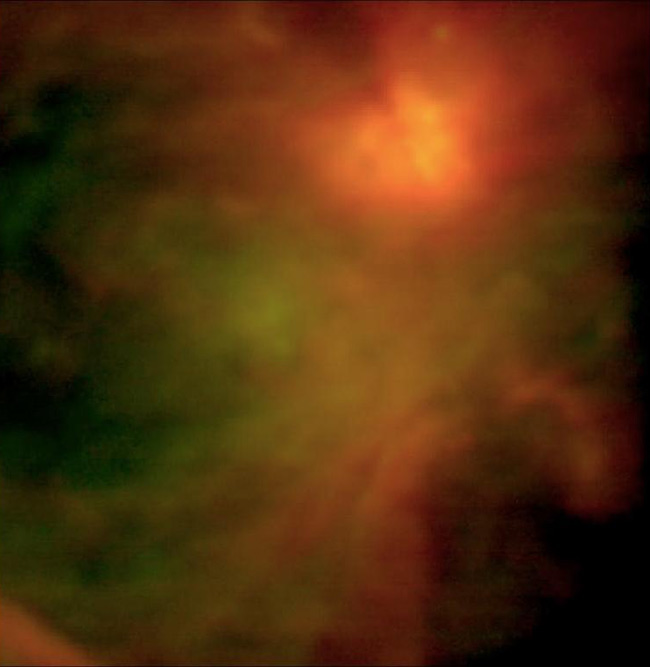Flying Telescope Snaps First Science Photos

A jumbo jet outfitted with aninfrared telescope completedits first science flight Dec. 1, making formal observations of thecosmos fromhigh up in Earth's stratosphere.
NASA's StratosphericObservatory for Infrared Astronomy, or SOFIA, took off froman Air Forcerunway in Palmdale, Calif., on Nov. 30. It flew for about 10 hours,capturingimages while in flight, before landing Wednesday morning, NASAofficials said.
SOFIA is a modified Boeing 747SP thatcruises at an altitudeof 39,000 to 45,000 feet (11,887 to 13,716 meters). It gets above mostof theinfrared-light-absorbing water vapor in Earth's atmosphere, affording aclearerview than ground-based infrared instruments are able to achieve. [Gallery:The Universe in Infrared]
SOFIA should therefore allowscientists to better understanda wide range of astronomical phenomena, including how stars and planetsareborn, how organic substances form in interstellar space and how supermassiveblack holes evolve, researchers said.
"These initial science flights mark asignificantmilestone in SOFIA?s development and ability to conduct peer-reviewedscienceobservations," Jon Morse, director of NASA's Astrophysics Division,saidin a statement. "We anticipate a number of important discoveries fromthisunique observatory, as well as extended investigations of discoveriesby otherspace telescopes."
SOFIA is fitted with an airborneinfrared telescope 8.3 feet(2.5 meters) wide. The aircraft's instruments can analyze light from awiderange of celestial objects, including the warm interstellar gas anddust ofstar-forming regions, by observing wavelengths between 0.3 and 1,600microns,researchers said.
A micron is one millionth of a meter.For comparison, thehuman eye can see electromagnetic radiation with wavelengths between0.4 and0.7 microns.
Get the Space.com Newsletter
Breaking space news, the latest updates on rocket launches, skywatching events and more!
The Nov. 30 flight marked the firstleg of SOFIA's earlyscience program. SOFIA used the Faint Object InfraRed Camera instrumenton thisflight, and will employ it on two upcoming jaunts as well, officialssaid.
In February 2011, engineers willinstall another instrument,the German Receiver for Astronomy at Terahertz Frequencies (GREAT), ontheplane. SOFIA will then make three flights with the GREAT instrumentduring thesecond phase of its science program, according to officials.
The Nov. 30 flight was not the firsttime SOFIA got off theground. The airliner snapped its firststratospheric photo during a test flight in May. And twoweeks ago, onanother test flight, it imaged areas within the Orion star-formationcomplex ?a region SOFIA investigated in more detail on the Nov. 30 flight,researcherssaid. [SOFIA image of Orion complex]
"The early science flight programserves to validateSOFIA's capabilities and demonstrate the observatory's ability to makeobservations not possible from Earth-based telescopes," said Bob Meyer,NASA's SOFIA program manager. "It also marks SOFIA's transition fromflyingtestbed to flying observatory, and it gives the internationalastronomicalresearch community a new, highly versatile platform for studying theuniverse."
SOFIA is an internationalcollaboration between NASA and theGerman Aerospace Center, Deutsches Zentrum fur Luft undRaumfahrt.
- Gallery:The Universe in Infrared
- Bigger,Better Space Telescopes Following in Hubble's Footsteps
- FlyingNASA Telescope Snaps First Photos from Stratosphere
Join our Space Forums to keep talking space on the latest missions, night sky and more! And if you have a news tip, correction or comment, let us know at: community@space.com.

Space.com is the premier source of space exploration, innovation and astronomy news, chronicling (and celebrating) humanity's ongoing expansion across the final frontier. Originally founded in 1999, Space.com is, and always has been, the passion of writers and editors who are space fans and also trained journalists. Our current news team consists of Editor-in-Chief Tariq Malik; Editor Hanneke Weitering, Senior Space Writer Mike Wall; Senior Writer Meghan Bartels; Senior Writer Chelsea Gohd, Senior Writer Tereza Pultarova and Staff Writer Alexander Cox, focusing on e-commerce. Senior Producer Steve Spaleta oversees our space videos, with Diana Whitcroft as our Social Media Editor.









